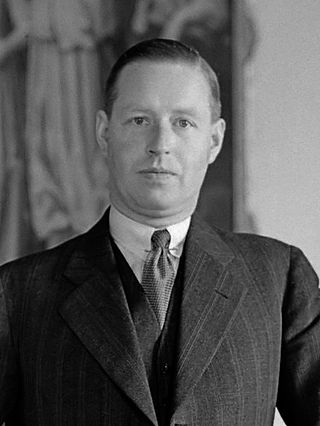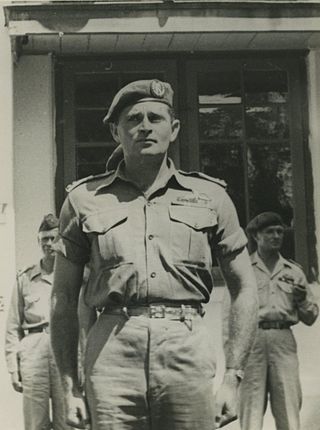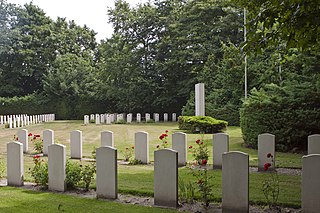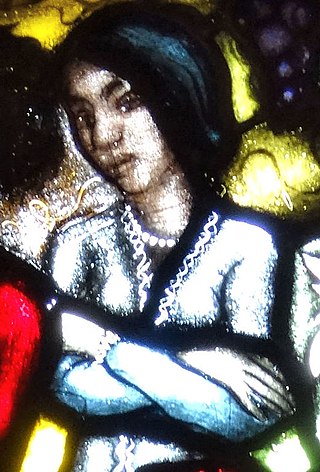
Rhenen is a municipality and a city in the central Netherlands. The municipality also includes the villages of Achterberg, Remmerden, Elst and Laareind. The town lies at a geographically interesting location, namely on the southernmost part of the chain of hills known as the Utrecht Hill Ridge, where this meets the river Rhine. Because of this Rhenen has a unique character with quite some elevation through town.

JonkheerAlidius Warmoldus Lambertus Tjarda van Starkenborgh Stachouwer was a Dutch nobleman and statesman, primarily noted for being the last colonial Governor-General of the Dutch East Indies, now Indonesia. He was taken captive after accepting Japan's demands for an unconditional surrender of the islands on 9 March 1942.

Raymond Pierre Paul Westerling was a Dutch military officer of the Royal Netherlands East Indies Army. He orchestrated a counter-guerrilla operation in Sulawesi during the Indonesian National Revolution after World War II and participated in a coup attempt against the Government of Indonesia in January 1950, a month after the official transfer of sovereignty. Both actions were denounced as war crimes by the Indonesian authorities. Born in the Ottoman Empire, despite his nickname, The Turk, Westerling was of mixed Dutch and Greek descent.

The Dutch East Indies, also known as the Netherlands East Indies and Dutch Indonesia, was a Dutch colony with territory mostly comprising the modern state of Indonesia, which declared independence on 17 August 1945. Following the Indonesian War of Independence, Indonesia and the Netherlands made peace in 1949. In the Anglo-Dutch Treaty of 1824, the Dutch ceded the governorate of Dutch Malacca to Britain, leading to its eventual incorporation into Malacca (state) of modern Malaysia.

Ancol is a coastal lowland area located to the east of Kota Tua Jakarta in northern Jakarta, in Indonesia. The coastal lowland stretched from Kota Tua Jakarta to the west and Tanjung Priok to the east. Today, Ancol contains the main beach resort of Jakarta. Taman Impian Jaya Ancol, the largest integrated tourism area in Southeast Asia, is located in Ancol.
During World War II, the Netherlands was the scene of five years of continuous air warfare between the Allied and the Nazis as the Netherlands lies en route from England to Germany and was designated and built up as the foremost line of Nazi air defence of Germany. Also, in 1944 there was heavy land fighting during the largest Allied airborne attack of the WWII in the south and east of the country in 1944–45. Thousands of airmen, soldiers and others of many nations were killed, and their war graves in some 4,000 locations are in the care of the Dutch War Cemetery Organisation.

The Indies Monument is a memorial in The Hague in memory of all Dutch citizens and soldiers killed during World War II as a result of the Japanese occupation (1942–1945) of the former Dutch East Indies. It is dedicated to all who died in battle, in prison camps or during forced labor. As stated in the mission statement of the 15 August 1945 Commemoration Foundation, it is also:
A place where you can pass on to your children the part of your childhood spent in the Dutch East Indies

The Rawagede massacre, was committed by the Royal Netherlands East Indies Army on 9 December 1947 in the village of Rawagede. Forces of the Royal Netherlands East Indies Army were battling Indonesian Republican army fighters TNI and militia forces seeking independence for Indonesia. Almost all males from the village, amounting to 431 men according to most estimates, were killed by the Royal Netherlands East Indies Army, since the people of the village would not tell them where the Indonesian independence fighter Lukas Kustaryo was hiding.

Grebbeberg War Cemetery is a Second World War military war grave cemetery, located on the Grebbeberg, a hill 2 km (1.2 mi) east of Rhenen the Netherlands. The cemetery contains 799 military personnel and one civilian who died during the invasion of the Netherlands by the Germans in May 1940. More than 400 of those interred in the cemetery fell during the Battle of the Grebbeberg.

The Netherlands Indies Civil Administration was a semi-military organisation, established in April 1944, tasked with the restoration of civil administration and law of Dutch colonial rule after the capitulation of the Japanese occupational forces in the Dutch East Indies at the end of World War II.

Dutch War Cemetery Menteng Pulo, also Dutch Field of Honor Menteng Pulo, is a war cemetery at Jl. Menteng Pulo RT. 3 RW. 12, Menteng Dalam, Tebet, Jakarta in Indonesia. It is one of two Dutch war cemeteries in Jakarta, the other one is Dutch War Cemetery Ancol at Ancol. Dutch War Cemetery Menteng Pulo was built to accommodate the victims of the war from the Japanese occupation during World War II. At present it is maintained by the Netherlands War Graves Foundation, which is an organization that manages all Dutch war cemeteries in the world.

The 1st Infantry Battalion of the Royal Netherlands East Indies Army was a Dutch colonial military unit that was active in the Dutch East Indies during World War II and the Indonesian National Revolution.

The Belgian Military Field of Honour 1914–1918, is a burial site located at the Oostergaarde Cemetery of the Dutch city Harderwijk in Gelderland. Originally, thirty-six soldiers were buried at the site. Nowadays, 349 Belgian soldiers from the First World War are commemorated. These include 124 individuals whose names feature on a monument because their remains could not be retrieved anymore. The cemetery was inaugurated on 28 September 1963 by the Belgian ambassador. The gravestones are similar to the ones used by the Commonwealth War Graves Commission and are varying from the official Belgian gravestones. The burial site is administered by the Dutch Oorlogsgravenstichting.

Melisande Tatiana Marie (Anda) Kerkhoven was a woman who joined the resistance during World War II. She was an important courier of the ‘De Groot’-group of Gerrit Boekhoven in Groningen. On 19 March 1945 she was shot by Dutch accomplices of the Sicherheitsdienst.
The Dutch Honorary Debts Committee Foundation is an independent interest group in the Netherlands and Indonesia for victims of Dutch colonialism in the former Dutch East Indies (1603–1949), in particular within the context of the Indonesian National Revolution of 1945–1949.

Dutch War Cemetery Kembang Kuning, also Dutch Field of Honor Kembang Kuning, is a war cemetery in Surabaya, East Java in Indonesia.

Dutch War Cemetery Candi, also Dutch Field of Honor Candi, is a war cemetery in the hills of Semarang, Central Java in Indonesia. Candi is one of two Dutch war cemeteries in Semarang, the other being Dutch War Cemetery Kalibanteng.

Dutch War Cemetery Kalibanteng, also Dutch Field of Honor Kalibanteng, is a war cemetery in the vicinity of the airport of Semarang, Central Java, in Indonesia. It is one of two Dutch war cemeteries in Semarang, the other being Dutch War Cemetery Candi.

Dutch War Cemetery Pandu, also Dutch Field of Honor Pandu, is a war cemetery in Bandung, West Java, in Indonesia.

Dutch War Cemetery Leuwigajah, also Dutch Field of Honor Leuwigajah, is a war cemetery just outside of Cimahi, West Java, in Indonesia.





















